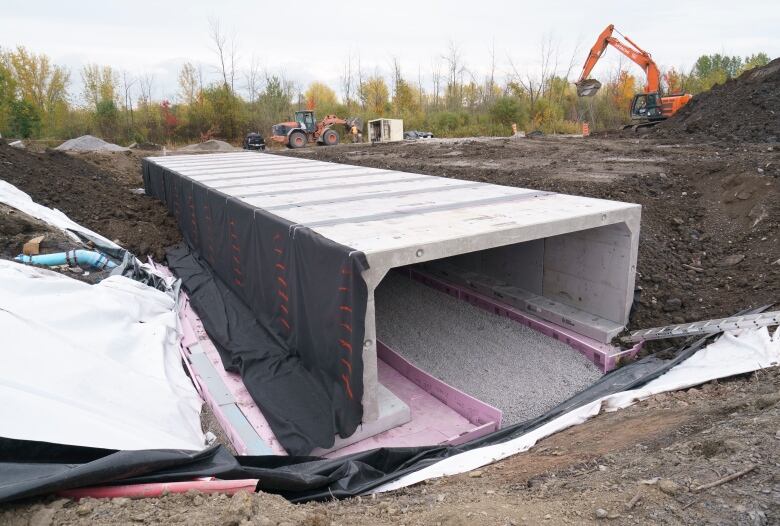In Longueuil, Que., there are all the makings of a road, from street lights to manholes, slicing through a thriving wetland.
But now heavy machinery sits idle nearby, black earth encrusted in metal treads, as snow collects on the frozen, 300-metre strip of clearcut land that’s lined with slim, willowy reeds, dried and rustling in the late-fall wind.
The road won’t be paved, and barriers will remain in place to prevent motorists from zipping down what was supposed to be a traffic-relieving connector running parallel to a heavily congested boulevard.
The municipal construction project, more than a decade in the making, was brought to a screeching halt by federal decree late last month to protect the western chorus frog, a threatened species under the Species at Risk Act.
It is now forbidden to dig, remove, tamp or plow soil on the frog’s 20-hectare territory.
That territory, located between residential development and farmland, is directly adjacent to a 260-hectare nature preserve known as the Boisé Du Tremblay.
The decree has outlawed draining the soil or altering surface water — something that already happened when crews installed a sewer system, drainage ditches and levelled the land in preparation of asphalt.

That’s why people like Tommy Montpetit worry that, even if the work has stopped, there are no clear plans to repair the damage.
“It’s going to be a major, major, major problem in the springtime. We have to stop the water from going into the drainage system,” said Montpetit, who has dedicated most of his life to protecting the endangered amphibian.
He is the conservation director for the environmental group, Ciel et Terre (sky and earth).
While this is the second time the federal government has taken action to protect the frog on Montreal’s South Shore, Montpetit said the fight is not over until the wetland is restored and fully protected.
“If we lose one year of reproduction for the western chorus frog, they’re gone,” he said.
New administration aims for scientific approach
Environmentalists fighting the project were able to catch the federal government’s attention just as Longueuil’s new mayor and councillors were celebrating their recent win.
“My mandate as mayor of Longueuil started in full force as the day after the election, a hearing was to be held concerning the injunction requested by environmental groups to stop the work to extend Béliveau Boulevard,” Mayor Catherine Fournier said on Facebook.
The $2.6-million road is supposed to connect R-100 Street to Béliveau Boulevard — creating a straight shot between de la Savane Road, where the Saint-Hubert Airport is found, and Jacques-Cartier Boulevard East, at the Pierre Boucher Hospital.

The city’s previous administration has touted the project as something residents have been demanding, saying it will have bike paths and sidewalks.
Longueuil built a wildlife corridor under the new road, costing the city nearly $1 million, and there’s a landscaped traffic circle on R-100 Street that will serve little purpose without the connection to Béliveau.
According to Quebec’s Ministry of Forests, Wildlife and Parks, 20 per cent of the chorus frog’s habitat is located there, making it the most important site the species occupies in the province.
Regardless, the provincial government gave the project the green light and construction got underway a few months ago.
Finally two Quebec environmental groups threatened to take the federal government to court if it failed to protect the frogs from the road expansion, and Ottawa took action.

Fournier said her administration opted to not fight the federal injunction, but instead use it as an opportunity to take a closer look at the project and protection of the frog. She has promised to lead the city with a science-based approach.
“In the meantime, our administration has also asked the teams to plan work to secure the site for the winter period and to take all the necessary measures to prevent drainage and contamination of the still preserved wetland area,” said Fournier.
Protecting the land permanently
Fournier said she is interested in protecting the natural environment, preventing real estate development in an area much larger than what is covered by the federal decree
Environment and Climate Change Canada says the frog now occupies only 10 per cent of the area it once did in Montérégie due to intense agricultural activities and urban development.

And people like Montpetit want the frog’s last bit of territory protected.
He wants Fournier to follow through with the help of the federal government to ensure all the undeveloped land between Boisé Du Tremblay and Roland-Therrien Boulevard — more than a kilometre in length — is protected permanently.
The land needs more than municipal protection, Montpetit explained, because local bylaws are either abused by developers or altered under new administrations.
It’s important to permanently protect the frog because, even though it is tiny (about the size of a grape), it plays a big role in the natural ecosystem, he said.
“People don’t get to see it very often. You don’t really see it. But the singing of the frog is absolutely beautiful. The frog is beautiful too,” he said.
“It’s really a big part of the ecosystem. It’s starting there. It’s the start of life.”






More Stories
Hubble Space Telescope marks 34 years with new portrait of a ‘cosmic dumbbell’
Prehistoric giant ‘sabre-toothed salmon’ renamed after new discovery | CBC News
What are microplastics doing to human health? Scientists work to connect the dots | CBC News